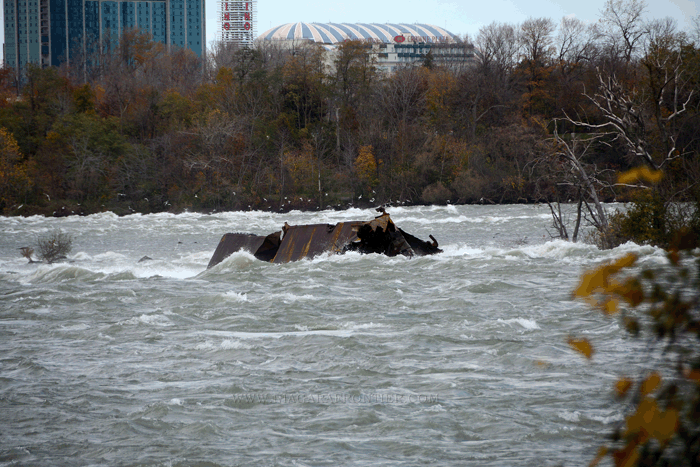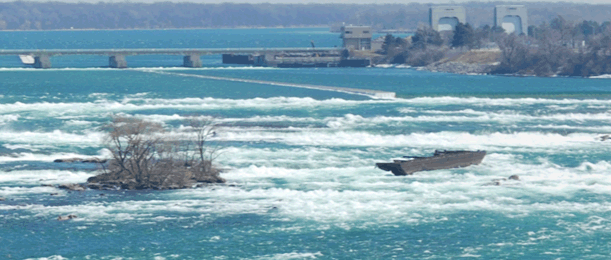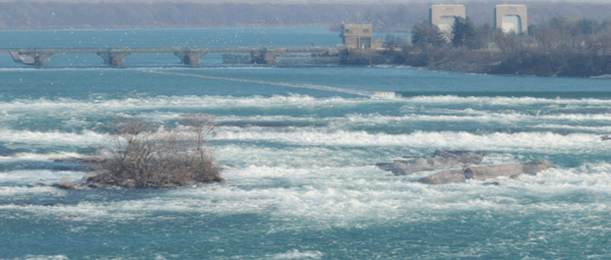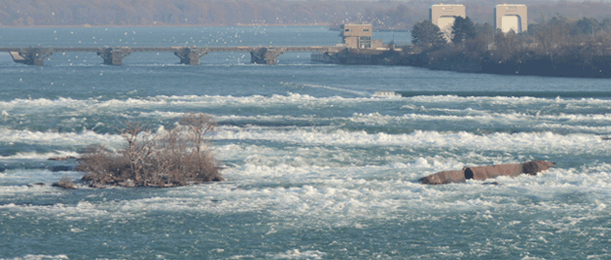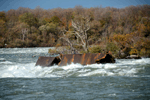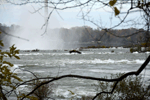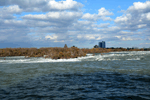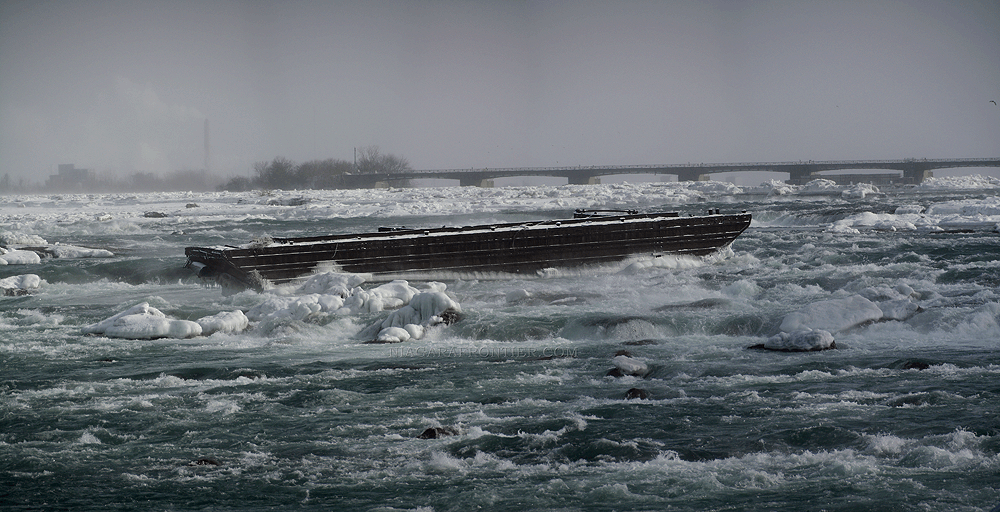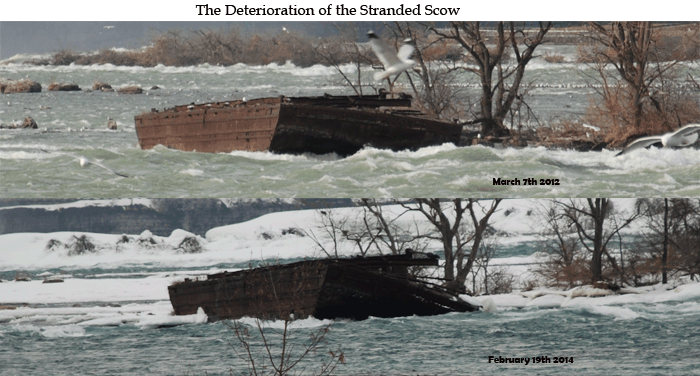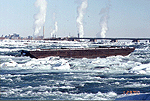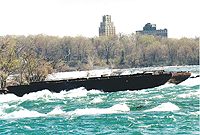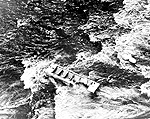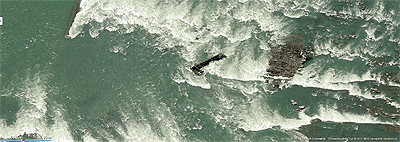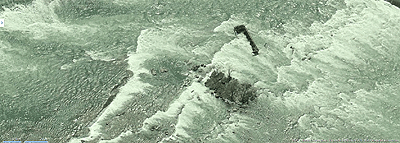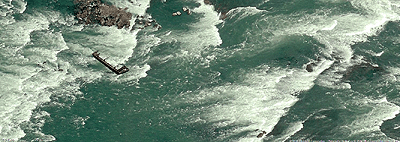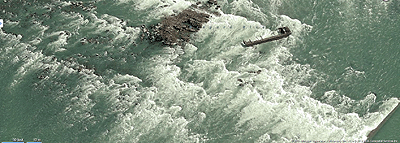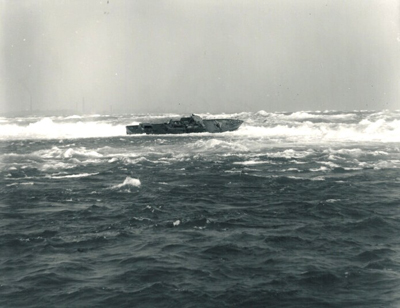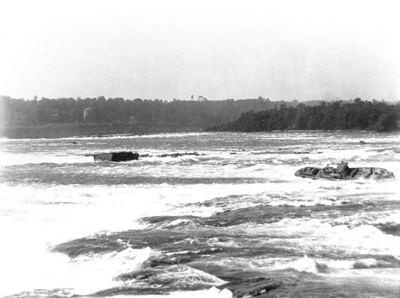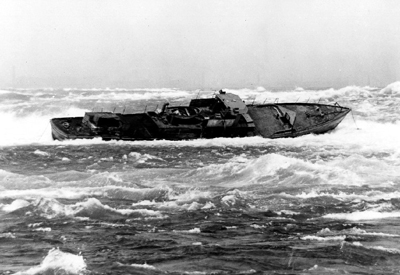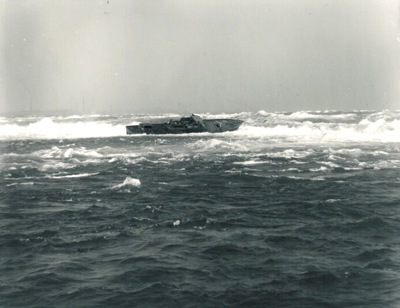THE SCOW (SAND BARGE)
BEFORE, DURING and AFTER
Niagara Falls November 1st 2019 -
The remains
of the Scow following October 31st 2019 wind storm On Thursday October 31st 2019, a major wind storm developed over the Niagara Frontier. Wind gusts peaked at near 60 mph (100 kms/hr) blowing from a west-south-west direction. At some point throughout the night and early morning of Friday November 1st, the scow was dislodged from the shoal upon which it had grounded upon in 1918. The scow appeared to have been overturned and driven by wind and water approximately 100 feet (30 meters) down river before being grounded again.
August 6th 1918
The Stranded Scow
SETTING THE STAGE At about 3:10 p.m. on the afternoon of Tuesday August 6th 1918, a steel copper bottomed sand scow (barge) was engaged in dredging operation in the fast currents on the American side of the Niagara River opposite Port Day at the entrance of the Niagara Falls Power Company hydraulic canal. The scow was being towed by the tug boat - "Hassayampa" being operated by Captain John Wallace along with the assistance of tug Mayer, with Captain Enos White and the tug Kinch, with Captain Charles Smith. The scow had two deck hands aboard. They were Gustave Ferdinand Lofberg, age 51 of 275 Mackinaw Street, Buffalo NY and James Henry Harris, age 40, a father of five children of 860 Niagara Street, Buffalo NY. Harris had no seafaring experience. He was a rigger by trade and had worked for the company for only one month. The Swedish born Lofberg was a weathered and seasoned saltwater sailor. He had worked on the Great Lakes for years. The tug and scow were owned and operated by the Great Lakes Dredge and Docks Company. They were operating at the head of the Hydraulic Power Companies' canal at 3:10 pm. A sand-sucker was being utilized to take sand from the bottom of the channel and deposit it into the barge.
SET ADRIFT During the operation, the tug Hassayampa suddenly struck and grounded on a rock shoal/sandbar approximately a ½ mile upriver from the Falls. The taut steel towline that held the barge to the tug snapped "like a thin string". The 80 feet long and 30 feet wide scow was set adrift. The tugs: Cowles and Helen M. of the Great Lakes Dredge and Docks Company fleet working in the hydro canal attempted to aid the scow but the current was too swift for the tugs to follow. The whistles of the five tugs on the river were blowing continuously. The four tugs went to the aid of the Hassayampa and the alarm was spread that the scow had broken free. Rome Coddington, superintendant of the Hydraulic Power Company arrived only moments after the barge was adrift. He notified the Niagara Falls Fire Department in Niagara Falls, Ontario and the Coast Guard stations at Buffalo and Fort Niagara. The powerless barge containing approximately 2,000 tonnes of sand and rock quickly drifted out of control downriver into the Canadian channel and towards the Horseshoe Falls. Lofberg and Harris were helpless and could do nothing to stop the scow. According to some reports, they were seen trying to slow the swift progress of the scow with the use of makeshift oars but with no success. The river descends 15 meters (50 feet) through a series of rapids and cascades. The Cascade area is divided into two channels by Goat Island. These channels carry the flow of the water to both the Horseshoe Falls and the American Falls. The rock strata located upstream of the Horseshoe Falls tilts 20 feet (6m) towards the Canadian shoreline in 1 mile (1.6 km).
GROUNDING Citizens rushed to the scene by the hundreds and had lined the banks of the river when the alarm was spread. they were kept a distance away because the power station had been previously sealed off by the military for security reasons using barbed wire and armed guards (WWI). Media reporters were later allowed into the inner perimeter by special permission. From a distance, citizens witnessed the two men working desperately on the barge. Harris and Lofberg made ready in hope that the scow would go aground, and it did about 2,500 feet above the brink of the Horseshoe Fall, over which only two persons had previously gone over in barrels and survived. Lofberg and Harris could only hope and pray for a miracle as they faced to see rising mist of the great Horseshoe Falls growing closer by the second. The roar of the Falls echoed in their ears. In a twist of fate, the scow swung sideways in the turbulent water, grounded and became lodged on a rock shoal 2,500 feet (767m) upriver from the Horseshoe Falls in the shallow but fast moving cascades. The barge had travelled about 1.25 miles. Although some reports indicate they opened or cut two holes in the bottom of the scow to allow water to enter the barge, they simply had no time. Other reports indicated that Lofberg and Harris had thrown a concrete anchor weighing about one ton into the water, opened the scow's bottom hatches causing it to bottom out but this simply wasn't true. Only after the scow had grounded itself on the rocky shoal did Lofberg and Harris deploy the anchor. After the scow had stopped moving and over the next twenty-four hours, Harris and Lofberg worked like demons making ready for the rescue that they knew would be attempted. They threw out the big anchor and it took hold on the rocks at the stern of the scow. With a sledge they knocked off the great chains that coupled to the "scow bar", a winch running the length of the craft. The chains would interfere with the use of the winch in hauling in a line that was expected to be shot to them from shore. Reports that they manually shifted about fifty tons of the load to the front of the scow to further secure the barge on the shoal was mere speculation.
RESCUE The alarm that the sand scow was being swept towards the Falls with two deck hands aboard spread throughout Niagara Falls, New York and the towns on the Canadian side. Hundreds of people crowded the buildings that lined the shore and the riverbanks to watch the human helplessness and the scow's progress. When the scow grounded it electrified everyone. Hundreds of men made for the point on the Canadian shore nearest the ledge. Employees of the Toronto Power Company who had watched the scow drifting in the river from the roof of the company building rushed to telephones. Calls were sent to the fire departments in Niagara Falls, New York and Niagara Falls, Ontario and to the Life Saving Station in Youngstown, New York. Benjamin Hall of Pennsylvania Street in Niagara Falls, New York, standing on the eastern tip of Goat Island witnessed the barge careening out of control through the rapids until it ground in mid stream just off the head of the island. At the urging of Mr. Hall, the Youngstown Life Savers (United States Coast Guard) were sent for. Lofberg and Harris began ripping huge timbers from the inside of the barge and were seen throwing some overboard. They were actually building a makeshift windlass (a winch device) in hopes that if a rope line from shore could somehow reach them they would be able to secure the line to the barge in order to hopefully prevent the barge from becoming dislodged and moving any closer to the Falls. A bungled haul would mean the dislodging of the scow. With sheer determination and with their very lives at stake, Lofberg and Harris completed building the clumsy windlass. The two stranded men could now only wait. Then Lofberg and Harris hauled in the line with the winch from which they had freed the chains that operate the trap doors in the scow's bottom. It was slow and terribly hard the two men took turns working at the winch. Each turn carried the heavy line only a trifle more than 3 inches nearer them. For more than three hours the men struggled with the winch.
A view
of the remains of the Scow in the Niagara River just upstream of the Horseshoe Falls
A rescue boat could not be utilized to rescue the two men because of the distance, the turbulence of the rapids and the proximity to the Horseshoe Falls. The Niagara Falls Fire Department was the first to arrive at the Power Company Building. They brought with them a small life saving gun. It was carried to the roof of the building. Fire Chief A. H. Newman discharged the gun. The rope rolled out towards the barge. It spun out about 300 feet (91.4m) before falling into the river. A second attempt was made but with the same result. In the meantime an army truck bearing five men from the Life Saving Station in Youngstown and their equipment including a larger gun and longer ropes. The five men were on their way from Fort Niagara at best speed driven by Private Fred Daubney. The truck made the 25 mile trip in 35 minutes. When the men from the Life Saving Station arrived with a Lyle gun capable of firing a lifeline to the scow, they mounted their gun on the roof of the Toronto Power House. The first shot to the scow with a light weight rope was successful shot over the barge. Lofberg and Harris grabbed the rope and began the process of pulling it aboard and connecting it to the windlass. In the meantime, the rescuers tied a much heavier rope to the end of the first rope. Lofberg and Harris began the long struggle of winding the rope in from the power house to the scow. The weight of the heavy rope was being carried downriver by the torrent of water and threatened in itself to dislodge the barge. At a time more than a hundred men on shore were needed to pulled the rope taunt in order to prevent this from happening. Scores of men who manned the lines on the roof of the Toronto Power Company plant, where the scorching rays of the sun mingled with the heat from the giant generators, made the place almost unbearable. After many hours of labour under terrifying conditions, Lofberg and Harris were able to bring the heavy rope aboard the barge and secure it to the windlass. By this time darkness had arrived. While awaiting rescue, Lofberg, thinking safety tied himself to the barge. Harris, on the other hand tied a rope around himself with the other end tied to a barrel. Harris thought that if the barge broke free, he could jump clear and hope that the barrel got caught up on more rocks. The first attempt to send a breeches buoy from the power plant to the stranded scow ended in failure just before midnight. All rescue efforts were suspended until morning. With nightfall, four huge searchlights were erected and trained on the scow and rescue rope. A breeches buoy (a chair like attachment) followed the line but became snarled half way across. Unable to continue because of the
darkness and because their voices could not be heard above the roar the
falls, an electric light was rigged up to
advise the stranded men that they had not been abandoned. The workers
cut letters in cardboard and placed them in front of the searchlights
thus making improvised electric signs. The rescue attempt was abandoned until first daylight. During the night while the lifesavers worked feverishly on the power house roof as a thunderstorm threatened but there was no rain. With the arrival of dawn, thousands of people crowded the shoreline watching this drama unfold. The morning was clear and the mist from the falls blew back onto the Canadian mainland. At first light. a second line containing the breeches buoy was successfully fired by the Lifesavers from the roof of the power plant to the scow. The rope was secured by Lofberg and Harris but the line had become entangled with the primary rope line. At 6 a.m. on Wednesday August 7th, Red Hill Sr. went out hand over hand along the rope as his body was tugged by the current of the rapids. Red Hill Sr. reached the tangled breech buoy and worked for hours until he was able to untangle it in order to allow the rescue. Hill dislodged the fouled ropes and was drawn back to the power plant. Still the buoy would not travel smoothly.
the
stranded Scow (barge) in the Niagara River in sight of the brink of the Horseshoe
Falls
At 8:30 a.m., Red Hill journeyed out again. This time Hill got within 130 feet (40m) from the scow. From here, he was able to talk to Lofberg and Harris. Hill discovered that one of the small coils of rope on the scow was wound around the big rope from the breeches-buoy, preventing the buoy from getting closer to the scow. Hill tried to shout directions to Lofberg and Harris but both had become so weak that they had difficulty untangling the rope. With Hill giving instructions and the persistence of both crew members, the rope was finally untangled. Hill returned to the roof of the Toronto Power House. Red Hill found one of the smaller ropes wound around the big line eight times. He was near enough to the scow now to talk to Harris and Lofberg. They were making feeble efforts to dislodged the fouled rope but were unable to do so because they were weak from hunger and exposure. Hill untwisted the rope but when he turned to give the signal for his return he found the ropes behind him fouled. Before he could be drawn back to the power house roof Hill had to untangle the ropes. He was drawn back to safety at last and the way was clear for the passage of the little buoy from the roof to the scow. With lines cleared after Hill's second trip out in the buoy, Lifesaver Capt. A. D. Nelson placed his men on the roof in positions to protect the lines and sent the little buoy with the white breeches dangling out on the big line. It traveled slowly and those who watched it from the shore and the roofs of buildings nearby became impatient. Finally it neared the scow. Charles Possert and Thomas
Dorrington, both riggers with the Toronto Power Company working the lines, the
breeches buoy was able to make his way to the stranded scow.
At the cataract house Harris waited
for him. A gray-haired woman guest looked at the two men in cried "thank
God you're saved I prayed for half the night!".
The Scow
(Barge) in the Niagara River opposite the Toronto Power Station just upstream of the Horseshoe Falls
Niagara Falls August 9th 1918 - Buffalo Express News No attempt will be made to reclaim the stranded scow on the reef of rocks above the Horseshoe Falls from which Gustave F. Lofberg and James H. Harris were rescued yesterday morning. Both R. Coddington, Superintendent of construction for the Hydraulic Power Company and W. J. McCarthy, Superintendent for the Great Lakes Dredge and Dock Company today denied the story that efforts will be made to salvage it. Mr. McCarthy said the scow would not be replaced today for less than $60,000 because of the high price of steel. But both Mr. Coddington and Mr. McCarthy said it would be impossible to get the scow safely to land because of the swift current of the river near it. Both said they would not consider endangering the lives of workers in an endeavour to bring it in. Lofberg and Harris worked today on another barge about a mile above the American Falls. They told their companies that their experience was all in a days work and that they were glad to be back on the job. They went to their sleeping quarters on one of the big dredges at the head of the hydraulic canal yesterday afternoon. They slept for many hours in their bunks and went to work this morning as if nothing had happened to disrupt their customary routine. Some reports indicated that Harris and Lofberg never returned to work on the Niagara River. Harris continued to live in Buffalo taking a series jobs unrelated to the river. Lofberg for a short time gave speeches about the scow and their escape. Harris died in Buffalo in 1939.
an
historical aerial photograph of the stranded Scow in the Niagara River
William "Red" Hill Sr. was awarded a Carnegie Life Saving Medal for his heroic efforts. The crew of the scow had been rescued without any loss of life. The loss of the barge was estimated by company officials at $36,000. Discussions about the possible salvage and recovery of the barge soon followed however it was expected that winter ice would soon dislodge the barge and carry it over the Falls. The sand barge (scow) although rusting and disintegrating with age, still remains in the same location where it became stuck. It is located just south of the Toronto Power House (which was closed in 1974) close to the Canadian shoreline.
"I thought I would drop a quick
line to let you know that my family enjoyed Niagara Falls November 1st 2019 -
The remains
of the Scow following October 31st 2019 wind storm On Thursday October 31st 2019, a major wind storm developed over the Niagara Frontier. Wind gusts peaked at near 60 mph (100 kms/hr) blowing from a west-south-west direction. At some point throughout the night and early morning of Friday November 1st, the scow was dislodged from the shoal upon which it had grounded upon in 1918. The scow appeared to have been overturned and driven by wind and water approximately 100 feet (30 meters) down river before being grounded again.
SUBCHASER "SUNBEAM" May 19th 1923
A view
of the Subchaser - "Sunbeam" in the Niagara River just upstream of the Horseshoe
Falls
In May of 1923, Mr. I. Seymour Lasker of Lasker Iron & Construction Company of Chicago purchased the 1914-1918 World War I, surplus Subchaser "Sunbeam" from the government. This boat which was originally built in Brooklyn, New York for the U.S. Navy in 1917 for use as a patrol boat, was to be converted into a private yacht for Mr. Lasker. The Subchaser "Sunbeam" was a wooden hull ship. It was 80 feet long with a 14 foot wide beam and 8 feet deep. The Sunbeam was equipped with three motors which generated 220 horsepower. At full speed, the Sunbeam could reach 35 miles per hour (mph). The three motors are valued at $7,000 each and the onboard compass at $600.
A view
of the Subchaser - "Sunbeam" stranded in the Niagara River
Jane's Fighting Ships -1943 Edition: describes old-type sub-chasers built between 1917-1919 as having a displacement of 75 tons; or 85 tons fully loaded. They were 105-110 feet in length with a beam of 14 feet - 9 inches. This ship had a full load draught of 5 feet - 8 inches. The subchaser was armed with one - 3 in., 23 cal., M.G. and D.C. The subchaser had three gasoline engines with 3 propeller shafts generating 660 horsepower @ 17knots. The subchaser carried 2400 gallons gasoline and could travel a distance of 900 miles at 10 knots. It carried a complement of 26 sailors.
Mr. Lasker came to New York with a crew of three including captain Charles McMahon; an engineer H.A. Lorenzen, and a cook. set out from New York for Chicago by way of the Erie Canal. They set out on a course up the Hudson river before turning westward through the Erie Barge Canal to the Tonawandas on the Niagara River that they thought would take them across Lake Erie. At Tonawanda a pilot was added to the crew in the person of Joseph Lee of Philadelphia. Lee was said to have sailed the upper great lakes for years. The Tonawandas' are located on the eastern bank of the Niagara River, midway between Buffalo and the Niagara Falls. Further downriver is Navy Island from which the mist plume from Niagara Falls can be clearly seen and the roar of the falls sounds a warning and every possible warning given, but the Sunbeam went on in a current that just ahead of them breaking On May 19th 1938 at 2:45 pm, the Sunbeam sped out into the river. those onboard hoped to into Lake Erie and be well on their way to Cleveland by nightfall. Unfortunately, they made a serious navigation error and turned downriver instead. arrived in Chippawa on the Niagara River several miles above the Falls. None onboard realized their mistake. Between Buckhorn Island (USA) and Navy Island (Canada) the Sunbeam made their way into deeper emerald green water. Further downriver on the Canadian shoreline was the Village of Chippawa. It was built along a creek (Welland River) that is being transformed into a feeder for one of the big power development schemes of Niagara.
A number of power company employees noticed the unusual boat coming down the river, and as it swept by the danger point they made frantic efforts to attract the attention of those onboard. Whistles were blown and every possible warning given, but the Sunbeam went on in the current that just ahead of them was breaking into the upper rapids. A big excavation had been made along the shore and for months scows had dumped their loads in the river to form a sandbar. Upon this soft bar the Sunbeam ran aground and stopped. Men working on the scow hurried out in a small boat and told the astonished voyagers of their danger and ferried all five of them to shore. All realized the Sunbeam was in a precarious position. The owner is said to have become disgusted at the turn of affairs and to have sold the boat to Joseph Lee for what money he had in his pockets. It was planned to try to save the submarine chaser on the following Monday morning, Canada being faithful in the observance of the Sunday labour law, but on Sunday the big river floated the Sunbeam off the sandbar and carried it further downriver towards the Horseshoe Falls. The Sunbeam grounded on a rocky shoal in the upper rapids close to the Toronto Power Station near the stranded scow (August 6th 1918) approximately 1000 feet from the shoreline and just upriver from the scow. The Sunbeam rests on it's port side with it's bow pointing upstream with the deck turned towards the shoreline. The cost to recover the subchaser was too expensive, so Mr. Lasker sold this vessel "as is" to William "Red" Hill Sr. for the sum of one dollar. Mr. Hill made plans to haul this boat off of the rocks by using shore stationed cranes however the Niagara Parks Commission required that a cash bond be put up in advance to cover any damage to the parkland. This cash bond was more money than Red Hill Sr. had hoped to make from the recovery from the salvage so he dropped his plans to do so. The subchaser was made of wood and was gradually broken into pieces in 1936/1937 by the winter ice until finally nothing was visible of the hull. Since 1961, with the maximum amount of water diverted for power purposes, the shoal on which the boat was stranded has come into sight in the winter season. The engines, propeller shaft and other heavy equipment of the vessel are now visible during low water periods.
Date last updated:
January 11, 2021
THANK YOU FOR VISITING
a
history
|
||||||||||
